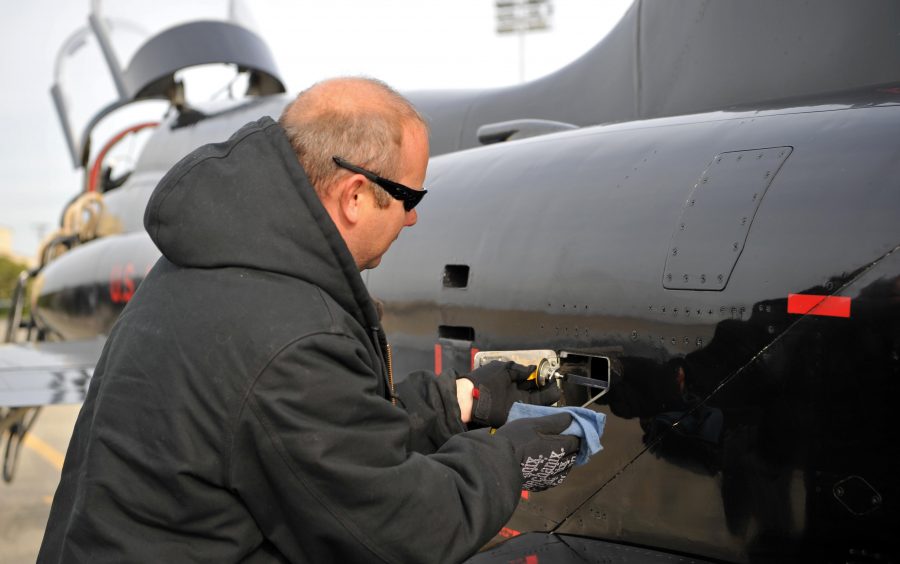Aviation borescope inspection is an important practice on any aircraft. Inspection requirements vary by craft type, and usage. For example, commercial and military aircraft are required to have a non-destructive inspection every 100 hours, while many small crafts are only required to have them done once every twelve months unless they are flown more than 200 hours a year. An inspection is also recommended when performance has started to lag.
Regardless of when you do your inspection, a special focus needs to fall on the engine of the aircraft. An airplane engine is made to withstand some extreme circumstances and prolonged use, but that does not mean that it is unbreakable. Routine inspection and maintenance can help prevent most instances of aircraft engine failure and prolong the life of the engine for thousands of hours of use.
Don’t Ignore These Signs
Aircraft engine maintenance, service, and repair begin with inspection. During inspection with tools like an aviation borescope, the operator can spot issues that indicate future, or imminent failure. Here are the six major signs that there is a problem with an aircraft engine.
1. Wear of Components
While components are not made to last forever, wear can indicate a few things. If the engine components have worn before it is time for them to be replaced, this will usually indicate a much larger problem. Premature wear is a secondary sign of a bigger problem.
2. Poor Lubrication
There are components of your airplane engine that require a good amount of lubrication. If these systems and components are dry, you need to wonder why. This could indicate that the engine is burning oil, there’s too much friction or too little friction. Proper lubrication is one of the most parts of any engine.
3. Contaminated Fluids
An aircraft engine is built to keep dirt and debris out of the fluids. As mentioned above, lubrication is an essential part of engine use. Should the engine oil, coolant, or anything other fluid become contaminated, you need to identify the source of contamination. Worn seals are a major offender of contamination throughout any part of the engine, especially the fluids — fluids can actually eat away at these seals over time. Once the source of contamination is identified, it needs to be corrected, and the fluids need to be completely flushed and replaced to prevent further damage from contamination.
4. Leaks
The implications of leaks can be extremely serious. Leaks not only let out fluids your airplane engine needs to operate, but they can also let in damaging contaminants. As mentioned above, contaminated can seriously sabotage the performance of fluids.
5. Cracks
If you have a crack in your engine, you have a serious problem. A cracked engine component is an indicator of a larger issue, typically that the part has become too brittle, and cracked during use. If there’s a crack in the engine block, you can soon expect much larger issues to arise, like loss of fluids and over-heating.
6. Corrosion
The internal engine components are not made to rust and corrode over time, so if you find corrosion, you are finding a spot in the engine that is getting water and air that shouldn’t.
With a thorough inspection using an aviation borescope, most of these issues can be found before they get out of hand. Take your time and study the information from the articulating video borescope, and get a second set of eyes on the issue, if needed. Being proactive with proper maintenance will ensure long-term performance and reliability.
Related Articles
Learn more about aviation borescopes and their real-world applications
Aviation Body & Engine
Aviation maintenance is a large and crucial part of the aviation industry as aircraft and engines are in constant need of inspection, preventative maintenance, and repair in order to keep these flying machines, running, effective and safe….
Most common aircraft turbine problems are avoidable with the use of an aviation borescopes to detect problems before they become disasters!
An aviation borescope is an invaluable piece of inspection equipment that any professional aircraft owner and mechanic need to have in their toolbox. Using one of these high-tech inspection tools can help….
How is An Aviation Borescope Used in a 100-Hr Inspection?
In the aviation industry, the use of borescopes is common as this is an invaluable inspection tool, and inspections are not only needed, they are required for most aircraft. Because of this, having a high-quality and reliable aviation borescope is a must for any professional ….
3 Types of Rocket Engines Used for Space Travel that Undergo Aviation Borescope Inspections
Space travel almost seems like its routed in pure magic, but a ton of engineering and highly advanced parts go into to make this ‘magic’ actually possible. Whether it’s manned or unmanned space crafts ….
Why a Military Aircraft Needs More Aviation Borescope Inspections Than Commercial Aircrafts
In the United States Military, there are currently over 13,000 aircraft in service to help protect our country. These include everything from transport aircraft, fighter aircraft, trainer aircraft, and so much more….
3 Most Commonly Used Commercial Aircrafts that Utilize Aviation Borescopes
The inspection process of an aircraft is vital to maintaining the right performance and operation standards of any and all aircrafts. Without a proper inspection, an aircraft is likely to run with undiagnosed issues….
Commercial Airplane Wing Inspection
Airplanes involve many different parts working together to make certain it operates smoothly. Commercial airplane wings are particularly….
Landing Gear Inspections
A commercial aircraft’s landing gear consists of large, main wheels situated at the middle of the plane near the wings. There is….


